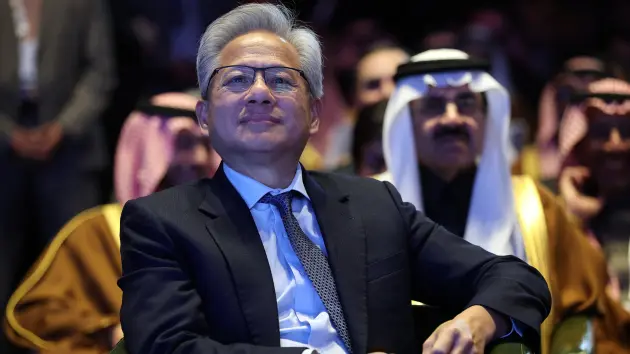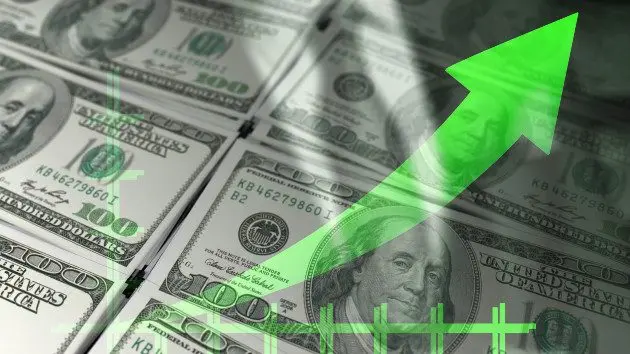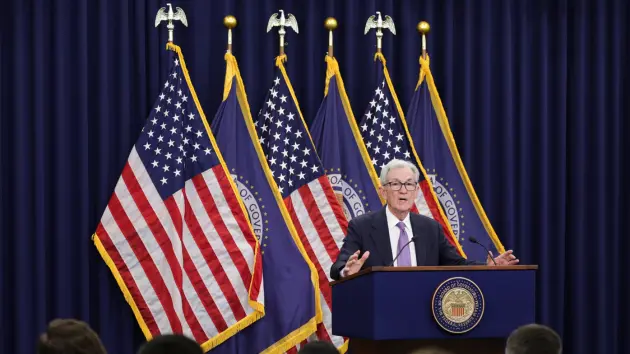
(NEW YORK) — Blockbuster earnings from chip giant Nvidia this week appeared to rebuke concerns about an artificial-intelligence bubble, briefly ending a days-long slump in the stock market.
“It’s fair to say that Nvidia’s results have completely changed the market mood and pushed out any bubble fears for another day,” said Jim Reid, a research strategist at Deutsche Bank, in a memo to clients early Thursday morning, just hours after the earnings.
But the market went on to offer little reassurance. Shares of Nvidia fell almost 3% in the first post-earnings trading session. The major stock indexes also dropped, underscoring the importance of the technology for Wall Street and the overall economy, which have both come to rely on massive AI spending to propel growth.
Nvidia recorded $57 billion in sales over three months ending in October, the company said on Wednesday, setting a quarterly sales record and demonstrating near-bottomless demand for the semiconductors at the heart of AI.
Still, critics say such appetite for the building blocks of AI has far outpaced the technology’s end uses and financial returns. AI hasn’t delivered much profit, they argue, despite up-front costs totaling hundreds of billions of dollars spent on data centers and chips.
Proponents strongly disagree, pointing to the rapid adoption of products like ChatGPT and counseling patience as other uses of the technology take hold. To hear them tell it, AI is set to augur a tech transformation like the internet or electricity, meaning the hype will ultimately bear out even if some firms falter along the way.
“There is no question that Nvidia will make a bunch of money,” Gary Marcus, a professor emeritus of psychology and neuroscience at New York University, who specializes in AI, told ABC News. “There are many questions about where the market is headed after this initial burst of enthusiasm.”
For his part, Nvidia CEO Jensen Huang rejected AI-related worries during an earnings call on Wednesday.
“There’s been a lot of talk about an A.I. bubble,” Huang said. “From our vantage point, we see something very different.”
The economy is undergoing a technological sea change that extends beyond generative AI, Huang said, noting the rise of advanced software such as cloud computing as well as AI-driven physical products — all of which increasingly run on Nvidia chips.
“Nvidia corporation is unlike any other accelerator,” Huang added.
AI spending is expected to total $375 billion this year, jumping to about $500 billion by the end of 2026, UBS Global Wealth Management found in August. For reference, the half-trillion to be spent on AI next year would be roughly equivalent to the gross domestic product of Singapore.
The AI boom has helped propel U.S. economic growth. Such spending added a 0.5 percentage point boost to annualized U.S. GDP growth over the first half of 2025, accounting for about one-third of economic activity, Pantheon Macroeconomics said.
But analysts fearful of an AI bubble warn of what they consider immense costs, saying energy needs and chip production have saddled the balance sheets of firms developing and operating AI models. Profits may not come for years, if at all, they warn. OpenAI said it expects to begin generating substantial profits in 2030.
Speaking to reporters earlier this year, OpenAI CEO Sam Altman acknowledged frenzied investor enthusiasm but signaled confidence about the long-term outlook for the industry.
“When bubbles happen, smart people get overexcited about a kernel of truth,” Altman said. “Are we in a phase where investors as a whole are overexcited about A.I.? My opinion is yes. Is A.I. the most important thing to happen in a very long time? My opinion is also yes.”
Tech giants like Amazon and Google retain the capacity to spend without taking on sizable debt, but smaller players require loans, risking credit defaults if the technology fails to deliver on the up-front costs, Marcus said. The potential unpaid loans could strain banks and put pressure on the wider financial system, he added.
“A big question is how much the banks have been propping this up: What will the blast radius be?” Marcus said.
Proponents of AI say such worries are overblown. They point to the popularity of products like AI chatbot ChatGPT, which boasts about 800 million weekly users. Millions of additional users avail themselves of xAI’s Grok, Google’s Gemini and Meta’s MetaAI.
Last year, Apple unveiled AI-fueled tools for its iPhones, Mac and iPad. Some firms are developing a new wave of AI-equipped robots to perform tasks in people’s homes and in workplaces like logistics and warehouses.
“This is the fastest adoption of any technology by consumers by far,” Lynn Wu, a professor of operations, decisions and information at the University of Pennsylvania, told ABC News. “This is a general purpose technology that will be adopted everywhere.”
The profitability of the technology will be made apparent over time as consumers and businesses identify its best uses, Wu added.
“When a general purpose technology — like electricity or the internet — is being adopted, firms and people don’t know how to use it,” Wu said. “We haven’t envisioned how to use this paradigm yet.”
Still, Wu cautioned, an AI bubble likely exists, though it isn’t dangerous. Wu compared the current state of the industry to the internet era before the dot-com bubble, when a host of firms went belly up but the technology reoriented the economy and established corporate giants.
“If you ask me flat out — yes or no — are we in a bubble? The answer is yes,” Wu said. “But the bubble isn’t necessarily a bad bubble.”
Copyright © 2025, ABC Audio. All rights reserved.



